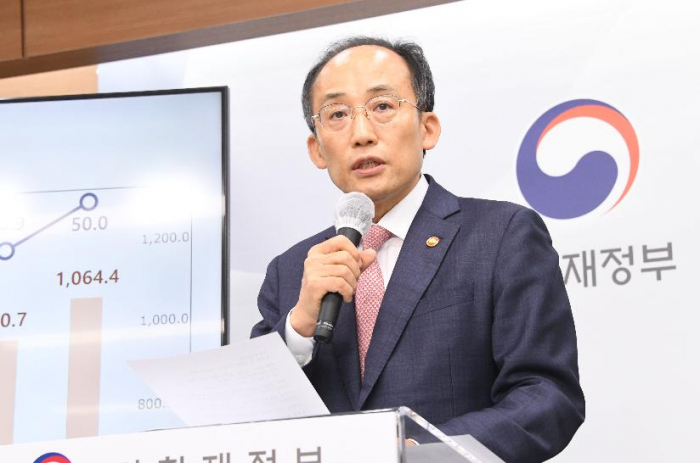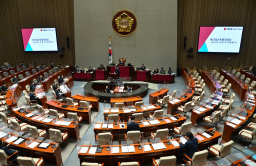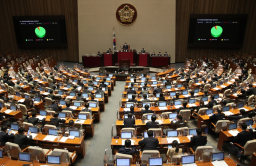-
KOSPI 2577.27 -2.21 -0.09%
-
KOSDAQ 722.52 -7.07 -0.97%
-
KOSPI200 341.49 +0.02 +0.01%
-
USD/KRW 1396 -2.00 0.14%
Korea to cut spending in 2023, first time in 13 years
Economy
Korea to cut spending in 2023, first time in 13 years
Fiscal deficit may narrow to 2.6% of GDP in 2023 from an estimated 5.1% this year; govt. aims to keep ratio at mid-2% until 2026
By
Aug 30, 2022 (Gmt+09:00)
2
Min read
News+

South Korea plans to reduce spending in 2023 for the first time in 13 years by cutting pandemic-era stimulus payments in a move to curb the country’s fiscal deficit and dampen inflationary pressure in Asia’s fourth-largest economy.
The Ministry of Economy and Finance on Tuesday said government expenditures will be 639 trillion won ($473.7 billion) next year in the first budget proposal under President Yoon Suk-yeol to be submitted to lawmakers later this week.
That is 6% smaller than this year’s spending of 679.5 trillion won, which included two supplementary budgets. If the government does not seek an extra budget for 2023, that would mark the first annual decline in spending since 2010.
Next year’s spending is 5.2% higher than the expenditures excluding the supplementary budgets. The growth is lower than an average of 8.7% increase during the Moon Jae-in administration from 2018 to 2022.
“Concerns are growing over South Korea’s fiscal soundness, which had been a strong point of the country’s creditworthiness worldwide,” said Finance Minister Choo Kyung-ho in a briefing on the budget proposal. “A shift from a loose fiscal policy to a sound fiscal one is essential to responsible fiscal operations for future generations.”
The previous Moon administration's expansionary fiscal policy, which partially aimed to support economic growth when COVID-19 hit the country, raised the sovereign debt to an estimated 1,068.8 trillion won this year from 660.2 trillion won in 2017. The debt-to-gross domestic product (GDP) ratio surged to 50% from 36% during the period. The fiscal deficit widened to a projected 5.1% of GDP from 1% in 2017.
With the tighter fiscal stance, the debt-to-GDP ratio is expected to ease for the first time in five years to 49.8% in 2023, while the fiscal deficit is likely to narrow to 2.6% of GDP, the finance ministry said.
LARGER SPENDING CUT
The government plans to cut 24 trillion won in spending by reducing public jobs for simple labor, streamlining fiscal investments, slashing expenditures related to COVID-19 and others.
That compared with the prior administrations that had pledged to cut spending for such areas by 10 trillion won.
“The finance ministry required to cut 10% of discretionary spending unconditionally from the beginning and it did not listen to any appeals to accept exceptions for some projects,” said a senior official from an economic ministry.
The country is set to reduce spending on the industries, small and medium-sized enterprises and energy sectors by 5.6 trillion won, or 18%, mainly due to the cut in temporary support for small business owners hit by COVID-19.

It plans to cut the expenditures for social overhead capital (SOC) by 10.2% to 25.1 trillion won by transferring some of the projects to local authorities. Spending on the culture, sports and tourism sectors will decline by 6.5% to 8.5 trillion won.
The Yoon administration plans to maintain a tighter fiscal policy until 2026 by managing the growth in spending at an average of 4.6%. It aims to maintain the fiscal deficit ratio to GDP at mid-2% and the debt ratio below the mid-50% level.
Write to Byung-Uk Do and Jung-hwan Hwang at dodo@hankyung.com
Jongwoo Cheon edited this article.
More To Read
-
Aug 31, 2021 (Gmt+09:00)
-
Dec 03, 2021 (Gmt+09:00)
-
 Treasury bondsKorea bond yields near four-year highs on extra budget
Treasury bondsKorea bond yields near four-year highs on extra budgetFeb 09, 2022 (Gmt+09:00)




